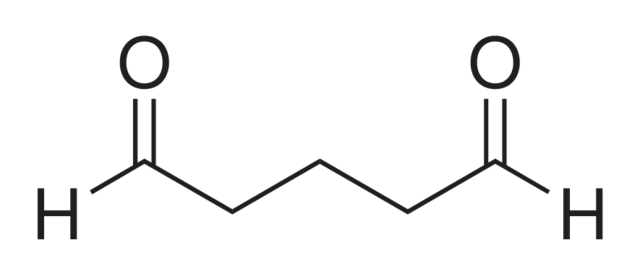Gluteraldehyde
General Information
Glutaraldehyde is a widely used chemical, some applications include: sterilant and disinfectant, leather tanning agent, tissue fixative, embalming fluid, resin or dye intermediate, and cross-linking agent, X-ray film processing, in the preparation of dental materials, surgical grafts, and bioprostheses, and as a fixative for electron microscopy.
Health and Safety
Glutaraldehyde can cause occupational asthma and skin sensitization responses such as contact dermatitis. It can cause severe irritation of the eyes, nose, throat, and lungs. Exposure related symptoms may include: shortness of breath, chest tightness, wheeze, cough, skin rash, hives, and irritation of the nose, throat, skin or eye. Gluteraldehyde can cause adverse effects when the vapor is inhaled or liquid contacts the skin. Direct contact with the chemical severely irritates the eyes and can cause permanent eye damage. Cal/OSHA has set a Ceiling Limit for the amount of gluteraldehyde in workplace air at 0.2 ppm. While skin contact is not prohibited under Cal/OSHA, it is important to avoid direct contact in order to avoid serious burns and development of allergies.
Good Lab Practices
Maintaining overall good laboratory work practices helps reduce the risk of hazardous exposures. Work in a fume hood when handling powders, crystals, or solutions, in order to prevent inhalation exposure. Wear a lab coat, long pants, closed-toe shoes, eye protection (Safety Glasses or Goggles), and appropriate gloves when working with gluteraldehyde. After completing your work leave lab coats, gloves, and other PPE in the lab to prevent the spread of this or other chemicals outside of the lab. Researchers and other users should be trained and understand the hazards, use, and proper cleanup procedures. Before conducting work the relevant standard operating procedures (SOPs) should be reviewed including the Safety Data Sheet (SDS) for gluteraldehyde. Please contact EH&S if your lab does not currently have an approved SOP for the use of gluteraldehyde.
Emergency Response
Eye care: If gluteraldehyde comes in contact with the eyes, immediately flush them with copious amounts of cold or cool water for at least 15 minutes, preferably in an emergency eyewash station.
Skin care: In the event of skin exposure, remove contaminated clothing and immediately wash the affected area with soap and copious amounts of cold or cool water for 15 minutes.
If swallowed or inhaled: In the case of gluteraldehyde ingestion, obtain medical attention immediately. If dry gluteraldehyde inhaled, move to a source of fresh air.
Spills: All labs should have a Spill Kit available. Anyone who uses gluteraldehyde or the spill kit must be trained how to use them.

